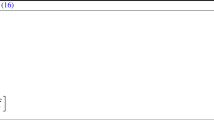Abstract
In a seminal paper, Witkin (1981) derived a model of surface slant and tilt recovery based on the statistics of the orientations of texture elements (texels) on a planar surface. This model made use of basic mathematical properties of probability distributions to formulate a posterior distribution on slant and tilt given a set of image orientations under orthographic projection. One problem with the Witkin model was that it produced a posterior distribution with multiple maxima, reflecting the inherent ambiguity in scene reconstruction under orthographic projection. In the present article, we extend Witkin’s method to incorporate the effects of perspective projection. An identical approach is used to that of Witkin; however, the model now reflects the effects of perspective projection on texel orientation. Performance of the new model is compared against that of Witkin’s model in a basic surface pose recovery task using both a maximum a posteriori (MAP) decision rule and a rule based on the expected value of the posterior distribution. The resultant posterior of the new model is shown to have only one maximum and thereby the ambiguity in scene interpretation is resolved. Furthermore, the model performs better than Witkin’s model using both MAP and expected value decision rules. The results are discussed in the context of human slant estimation.
Similar content being viewed by others
References
Blake A, Marinos C (1990) Shape from texture—estimation, isotropy and moments. Artifi Intell 45: 323–380
Blake A, Bülthoff HH, Sheinberg DL (1993) Shape from texture—ideal observers and human psychophysics. Vis Res 33: 1723–1737
Brady M, Yuille A (1984) An extremum principle for shape from contour. IEEE Trans Pattern Anal Mach Intell 6: 288–301
Braunstein ML (1968) Motion and texture as sources of slant information. J Exp Psychol 78: 247–253
Buckley D, Frisby JP, Blake A (1995) Does the human visual system implement an ideal observer theory of slant from texture?. Vis Res 36: 1163–1176
Eagle RA, Hogervorst MA (1999) The role of perspective information in the recovery of 3D structure-from-motion. Vis Res 39: 1713–1722
Gårding J (1993a) Direct estimation of shape from texture. IEEE Trans Pattern Anal Mach Intell 15: 1202–1208
Gårding J (1993b) Shape from texture and contour by weak isotropy. J Artif Intell 64: 243–297
Gibson JJ (1950) The perception of the visual world. Houghton Mifflin, Boston
Gruber HE, Clark WC (1956) Perception of slanted surfaces. Percept Mot Ski 6: 97–106
Hogervorst MA, Eagle RA (2000) The role of perspective effects and accelerations in perceived three-dimensional structure-from-motion. J Exp Psychol Hum Percept Perform 26: 934–955
Horn BKP, Brooks MJ (1989) Shape from shading. MIT Press, Cambridge, Mass
Kanatani K (1984) Detection of surface orientation and motion from texture by a stereological technique. Artif Intell 23: 213–237
Knill DC (1998) Surface orientation from texture: ideal observers, generic observers and the information content of texture cues. Vis Res 38: 1655–1682
Knill DC (2003) Mixture models and the probabilistic structure of depth cues. Vis Res 43: 831–854
Koenderink JJ, van Doorn AJ, Kappers AML (1992) Surface perception in pictures. Percept Psychophys 52: 487–496
Li A, Zaidi Q (2000) Perception of three-dimensional shape from texture is based on patterns of oriented energy. Vis Res 40: 217–242
Malik J, Rosenholtz R (1997) Computing local surface orientation and shape from texture for curved surfaces. Int J Comput Vis 23: 149–168
Mamassian P, Landy MS (1998) Observer biases in the 3D interpretation of line drawings. Vis Res 38: 2817–2832
Mamassian P, Landy MS, Maloney LT (2002) Bayesian modelling of visual perception. In: Rao R, Olshausen B, Lewicki M (eds) Probabilistic models of the brain: perception and neural function. MIT Press, Cambridge, MA, pp 13–36
Mardia KV, Jupp PE (1999) Directional statistics, 2nd ed. Wiley, Chichester
Mingolla E, Todd JT (1986) Perception of solid shape from shading. Biol Cybern 53: 137–151
Rosenholtz R, Malik J (1997) Surface orientation from texture: isotropy or homogeneity (or both)?. Vis Res 37: 2283–2293
Seyama J, Takeuchi T, Sato T (2000) Tilt dependency of slant after-effect. Vis Res 40: 349–357
Stone JV (1993) Shape from local and global analysis of texture. Phil Trans R Soc Lond B 339: 53–65
Velisavljevic L, Elder JH (2006) Texture properties affecting the accuracy of surface attitude judgements. Vis Res 46: 2166–2191
Warren PA, Mamassian P (2003) The dependence of slant perception on texture orientation statistics. J Vis, 3, abstract 847
Witkin AP (1981) Recovering surface shape and orientation from texture. Artif Intell 17: 17–45
Author information
Authors and Affiliations
Corresponding author
Electronic Supplementary Material
Below is the Electronic Supplementary material.
Rights and permissions
About this article
Cite this article
Warren, P.A., Mamassian, P. Recovery of surface pose from texture orientation statistics under perspective projection. Biol Cybern 103, 199–212 (2010). https://doi.org/10.1007/s00422-010-0389-3
Received:
Accepted:
Published:
Issue Date:
DOI: https://doi.org/10.1007/s00422-010-0389-3



